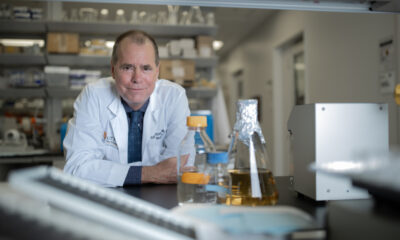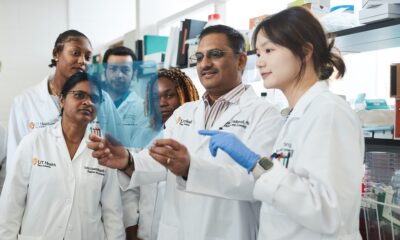New discoveries in pediatric cancer research

Mays Cancer Center Annual Report
Researchers at UT Health San Antonio have identified a mechanism through which two antiviral genes, when mutated, promote a rare childhood cancer called pediatric myelodysplastic syndrome (MDS). MDS is characterized by abnormal stem cell function in the bone marrow, resulting in lower numbers of blood cells than normal.
When normal, the genes — called SAMD9 and SAMD9L — suppress tumor formation and help protect against infection by viruses. They are effective and selective sentinels.
“Normally those two genes are silent in the cells, only becoming activated when they encounter infection,” said senior author Yan Xiang, PhD, professor of microbiology, immunology and molecular genetics. “However, if an individual has a mutation in these two genes, they are turned on, even without infection. And that can cause a lot of diseases.”
Since 2017, studies have found that about 8% of pediatric MDS patients have mutations in the two genes. That makes SAMD9/SAMD9L errors the most common currently known cause of MDS in children. These children have fewer immune cells than normal and a high tendency to develop acute myeloid leukemia.
This new study, first published in the Proceedings of the National Academy of Sciences of the United States of America, contributes two key findings for a potential treatment:
- Patient-derived SAMD9/SAMD9L mutations lead to a stall in protein synthesis in cells and prompt a stress response to abnormal protein synthesis. This could explain why children with the mutations have an underdeveloped immune system. Other studies have hinted at protein synthesis as the problem.
- SAMD9 and SAMD9L proteins have a specific region that is critical for their function. When the researchers deactivated this region, they stopped the toxic effects of the mutated proteins.
The team also found that this protein region performs the toxic function through binding to nucleic acids, which are molecules that store and express genetic information.
“Since we have the structure of that region, and we know its function, we believe we have identified a key therapeutic target for pediatric myelodysplastic syndromes derived from SAMD9 and SAMD9L mutations,” Xiang said. “We hope to eventually develop a molecule to target that region.”
To date, bone marrow transplant is the only treatment option for children who have SAMD9 and SAMD9L mutations.
RNA ‘heroes’ can disarm bad-actor proteins in leukemia
In a pediatric cancer study first reported in the journal eLife, scientists believe it may be possible to prevent DNA changes driven by two proteins highly active in leukemia and other cancers. The new mechanistic target for drug development can alter the chemical structure of DNA, according to the study’s senior author Yogesh Gupta, PhD, associate professor of biochemistry at The University of Texas Health Science Center at San Antonio’s Greehey Children’s Cancer Research Institute.
The proteins, called METTL-3 and METTL-14, can alter the chemical structure of DNA — the molecular vault in cells that stores a person’s genetic information. This is a new understanding, said Gupta. For 27 years since the discovery of METTL-3 and -14, scientists believed that the proteins could only alter a separate molecule called RNA, but not DNA, he said.
RNA molecules, which float inside cells either reading out DNA instructions to make proteins or influencing this process indirectly, can form different shapes such as hairpins. Gupta and his team also observed that RNA of a certain structure like a hairpin can act as a glue that binds to METTL-3 and -14, preventing it from changing DNA’s chemical structure.
“It is a desirable therapeutic target,” Gupta said. “By uncovering the DNA-altering function of METTL-3 and -14 and learning that it can be regulated by certain RNAs, we provided information that will help in drug discovery research.
“Our next step is to understand DNA, RNA and METTL-3 and -14 interaction so that we can identify the areas on the proteins for the purpose of drug development,” said Gupta.




